Excerpts from Jim Conrad's
Naturalist Newsletter
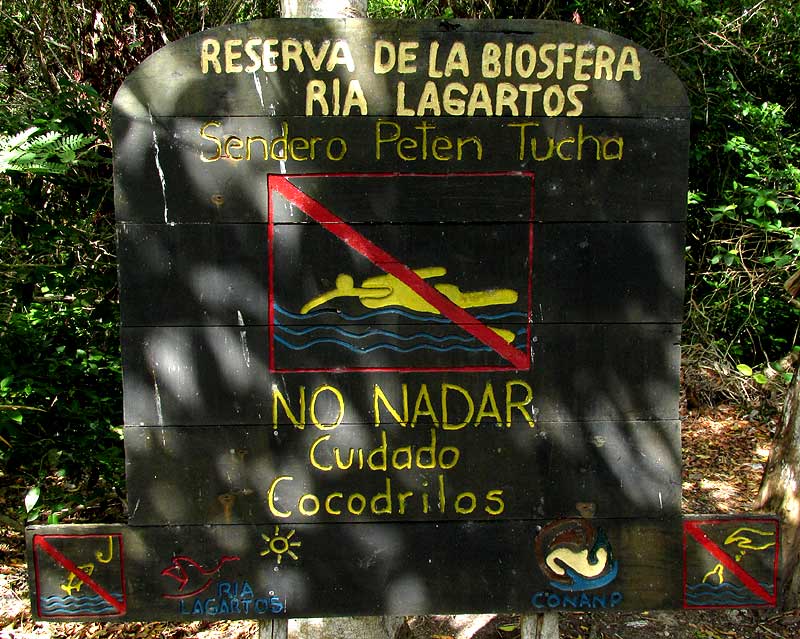
from the May 17, 2015 Newsletter issued from Río Lagartos, on the Yucatan Peninsula's northern coast (~N21.60°, ~W88.16°), Yucatán state, MÉXICO
PICTOGRAMS ON BIOSPHERE SIGNS
At pretty Petén Tucha deep in the mangroves a few kilometers along the coastal road west of Río Lagartos, the Mexican agency responsible for administering Ría Lagartos Biosphere Reserve, CONANP (Comisión Nacional de Áreas Naturales Protegidas), has erected a sign advising visitors that they shouldn't swim in the pond's clear, inviting water because of crocodiles. For those who can't read Spanish, a sign expresses the prohibition with a pictogram, as shown above.
Pictograms at the sign's bottom also tell us that no fishing is allowed in the pond, and that we shouldn't throw trash such as bottles into it. These bottom ones are fairly easy to interpret, but the main one symbolically portraying someone being swallowed by a crocodile borders on abstraction, and one is drawn to analyze it as if it hang on the wall at the Met. Why does the crocodile seem to bear a crest? What does that yellow blob at the lower right represent?
At the sign's bottom, the symbol for CONANP itself -- the round thing with a white middle looking like a snail with a tiny shell -- borders on the uninterpretable. I think the white part is Mexico, Baja California on the left and the Yucatan on the Right, with the blue Pacific below but, is that a brown, ambiguous, miniaturized North America at the top? Also at the sign's bottom are a stylized red flamingo and a yellow sun happily issuing sunbeams for us all. Seeing this sign so busy with artwork, one gets the impression that someone at CONANP loves fiddling with symbols, and maybe the symbols are worth paying attention to.
In fact, once you're into these signs, you start looking for the sign-artist's more spectacular leaps into fantasy. For example, along a road through the mangroves, there's the sign shown below:
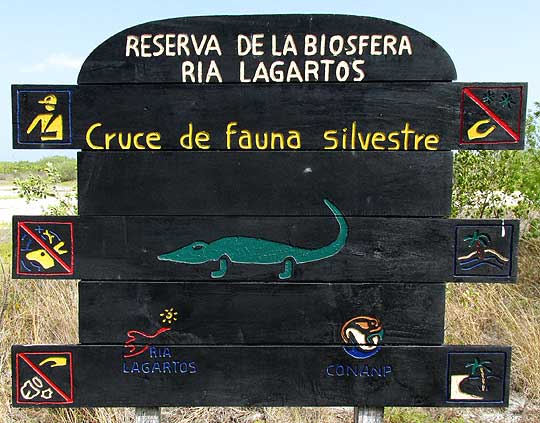
That's a crocodile-crossing sign, but while they're at it they also tell us that the area is policed, and that we shouldn't shoot the wildlife or throw trash onto the ground, but that we should enjoy the nearby beach and river. However, that symbol at the top, right needed some cogitation. The red bar indicates that we're not supposed to do something. Eventually I decided that the two, hardly visible, dark-blue stars are fireworks and that the yellow wrench-tip-like-thing is a hand, so the message is "No Fireworks," I think. One's first impression is that this pictograph verges on failure, but then you wonder how else one might convey in symbols simple enough for woodworkers to carve into wood and paint with a palate of limited colors that no fireworks are allowed?
Farther up the road, a sign declaring limited access to the Biosphere's Nuclear Zone #2 offers another pictograph exhibition, as seen below:
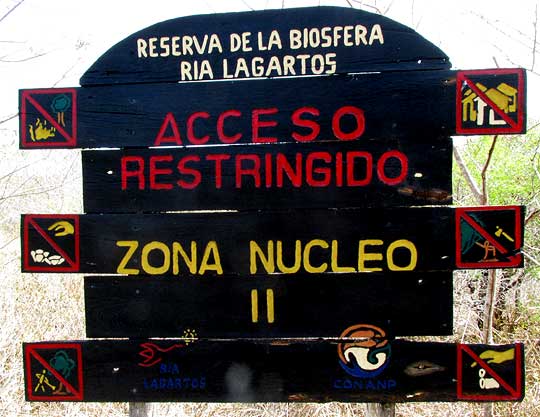
"No burning," "No building," "no leaving trash," and "no chopping down trees," the pictographs say. I think the one at the lower, left means "No machete-hacking of the undergrowth," but I puzzle over the one at the left of the word ZONA. Maybe those white things are flowers, so "Don't pick the flowers," maybe, though the white things really look more like cat footprints.
Yet farther up the road another sign appears, shown below:

It warns us of the danger of fires, with the added admonitions that we shouldn't make campfires (I think), shoot wildlife, or cut trees, but that we should cherish our trees and... what?
That sign bears two symbols, both on the sign's right side, top and bottom, that I can only guess about. In some parts of the Yucatan the soil is so thin or absent that folks rob soil and carry it home, so maybe the top, right one means "Don't steal the dirt." However, that one at the bottom, right, appearing to be a bird atop two fish leaping from the water and kissing, just stymies me, unless it simply means "Enjoy the birds and fish."
On certain big signs the symbols are larger, so the artist has more freedom to add detail. On one such big sign the above "kissing fish" symbol has more detail but only grows more mysterious, as shown below:
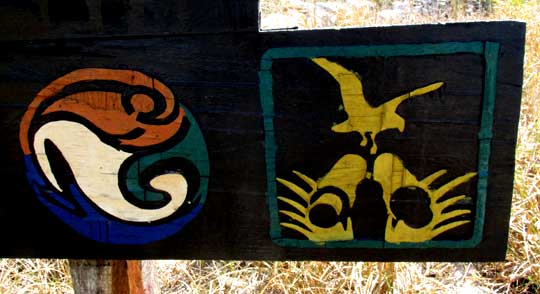
The larger CONANP symbol on the left clarifies itself, though. What previously seemed a depauperate North America now resolves into what is surely an angel with wings spread benevolently over Mexico. The oceans are more clearly oceans there, and it's certain that Central America just isn't there.
But, that fish-kissing one... Any ideas, anyone?
from the May 24, 2015 Newsletter issued from Río Lagartos, on the Yucatan Peninsula's northern coast (~N21.60°, ~W88.16°), Yucatán state, MÉXICO
PICTOGRAM UPDATE
Of all the pictograms admired above, the most mysterious to me was the one shown on the right at the above picture -- the last one in last week's entry
Mark in the UK, Pam in Colorado and Diego here in Río Lagartos understood the message, which becomes apparent when you see that the "fins" are actually fingers of hands, and the hands are holding a pair of binoculars shown in perspective, directed toward the raptor. Maybe the person who painted the flaring fingers hadn't known how to hold binoculars; also, each hand seems to bear five fingers and a thumb.
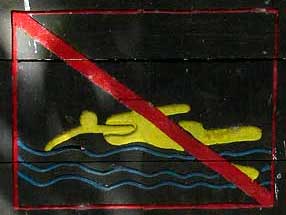 Bea in Ontario saw something even more interesting, in the "No swimming because of crocodiles" sign. That pictogram shows a swimmer being gulped down by a crocodile, but the crocodile inexplicably bears a crest atop its head, and something yellow is floating apart in the water, as shown at the right.
Bea in Ontario saw something even more interesting, in the "No swimming because of crocodiles" sign. That pictogram shows a swimmer being gulped down by a crocodile, but the crocodile inexplicably bears a crest atop its head, and something yellow is floating apart in the water, as shown at the right.
Bea added some yellow to the picture to create a less ambiguous pictogram, shown below:

It looks like the sign painter decided to improve on a standard symbol showing a swimmer by adding a line to create a crocodile's mouth, but the effect was marred by leaving inappropriate parts of the swimmer where they shouldn't be if the swimmer had been disappearing into the crocodile's belly. The artist had a fine inspiration, but didn't execute well.
So, that leaves only a couple of ambiguous pictograms -- the "Don't steal dirt" one and the "Don't pick the flowers" one, where the flowers look more like cat footprints. I'll let you know if anyone figures those out.